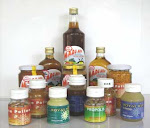Is the food of the queens-originally for the queen bees but also beneficial for both women and men. Queen bees are made, not born, and their feeding with royal jelly is the key to that process. Without this special food, queen bees would fail to develop properly.
Royal jelly is an extremely nutritious, thick, milky-white creamy liquid secreted by the hypopharryngeal glands of the nurse bees. Queen bees live exclusively on royal jelly and it accounts for their incredible size, fertility, and longevity.
Queen bees are born from the exact same eggs as worker bees. The only difference is they are fed exclusively royal jelly. They are on average 42% larger than worker bees and perhaps most amazing, the queen bee lives 40-50 times longer than worker bees while producing more than 2-1/2 times her own body weight of eggs each and every day. This extraordinary reproductive fertility, energy, size, and longevity of the queen bee is symbolic of dramatically improved endocrine health.
Royal jelly produces an age-retarding, longevity enhancing effect. It helps maintain health, beauty, and youth; helps normalize body functions; protects against infections; increases resistance to diseases; and increases endurance and energy levels. It is antibacterial and anti-viral, particularly against streptococcus, E-coli, and staphylococcus. Royal jelly accelerates the formation of bone tissue and helps heal wounds in half the time.
Like bee pollen, it is a rich treasure chest of nutrients and energy. It is 12-13% protein, 12-15% carbohydrates, 5-6% beneficial lipids, including the important fatty acids, and contains the full spectrum of vitamins. Royal jelly is high in the B vitamin pantothenic acid, recognized for its ability to reduce stress levels. It supplies the minerals calcium, copper, iron, phosphorous, potassium, silicon, and sulfur. Royal jelly contains sterols, phosphorous compounds, and acetylcholine. Acetylcholine is needed to transmit nerve messages from cell to cell. Too little of this compound makes individuals prone to various nerve disorders including Parkinson's disease, Alzheimer's, and Multiple Sclerosis.
Royal jelly is high in amino acids which are necessary for human and animal life. It contains at least 17 amino acids, including the 8 essential amino acids, plus 5 unidentified related compounds. Aspartic acid is a major amino acid-necessary for tissue growth and building-at 16.1% of the royal jelly protein content. It contains the amino add gamma globulin, which helps your immune system help fight off infections. Half the total fatty acid content is 10-hydroxy-2-decanoic acid (10-HDA) which is involved in growth, regulation, and immunity. 10-HDA comprises 2-15% of total weight of whole royal jelly. Royal jelly also contains pheromones and numerous other identified and unidentified substances.
Royal jelly is rich in the important nucleic acids RNA and DNA, which produce many benefits throughout your body. Gelatin, another significant component, is the primary precursor of collagen or connective tissue. Collagen is an anti-aging element that keeps your skin looking smooth and youthful, helps your muscles and bones function properly, and supports your. organs and glands.
Research indicates the following :
Benefits:
- Increases the life span of insects and mammals by 30-200%
- Hens doubled their laying. Old hens started laying again. Older roosters became reproductive again
- Women became fertile after menopause
- Impotent men became potent again
- Rejuvenates the cells by providing factors the system lacks, and those using it developed a greater feeling of well being
- People reported it prolonged life and restored health, vigor, and reproductive functions
- Tones and strengthens your skin
- Alleviates anxiety and moodiness
- Strengthens and stimulates your immune system
- Contains a complex compound that acts as a glandular secretion that stimulates glands and helps normalize the reproductive systems of both women and men because it acts as a natural hormone precursor
- US Food and Drug Administration research shows it is bactericidal including killing microbes like staphylococcus aureus, bacilli coli, eberthella typhosa (Rawlins strain), bacilus mettiens, etc
- Stimulates growth of newborn children, especially those born prematurely or with hypotrophy
- Beneficial for a arteriosclerosis and atherosderosis
- Regenerates bone growth
- Anabolic effect on tissue production and growth
- Helps wounds heal, benefits inflamed bladders, and gradually decreases pains
- Increases the number of red blood cells and immune cells
- Accelerates healing of inflammatory processes
- May produce an anti-cancer effect
- Has a liver protective effect
Other therapeutic claims include:
- Increases appetite
- Increases vigor and physical strength
- Relieves weak and tired eyes
- Helps women during critical periods of life such as pregnancy and menopause
- Rejuvenates the aged
- Diminishes fatigue
- Relieves and often eliminates pain of arthritis
- Strengthens power of memory
- Restores reproductive energy
- Regenerates debilitated organs
- Helps nervous and vascular problems such as Parkinson's disease
- Reactivates glands and helps glandular disorders
- Benefits nervous disorders such as cerebral neuritis and nervous debility
- Benefits diabetes, asthma, sterility in women, impotence in men, and chronic degenerative diseases
Royal jelly is available alone as a pure jelly-like substance that should be kept in the refrigerator or freezer. It is also available in honey, which acts as a natural preservative, or freeze-dried (lyophilized) and available in capsules, tablets, chewables, as well as combined with other natural substances such as other bee products. It is available as a liquid, often again mixed with honey. It is also used in cosmetic and skin care products, and is available in creams, salves, ointments, and other products.
Footnotes
Barker, S. Nature, 183:199. 1959.
Hoyt, M. The World of Bees. Bonanza Books, New York. 1965.
Morko, P. Nature, 202:188. 1964.




